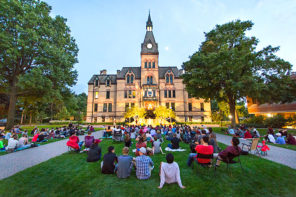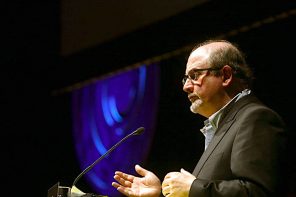Here at the Center for Religious and Cross-cultural Studies in Yogyakarta we were very surprised when a PBS team showed up at our offices to do a story on the Merapi eruptions.
The story they told is accurate and reflects the interplay of science and religion in the ways that people here in Yogyakarta understood the disaster — mostly. But I was not happy to hear the word “superstition” used to describe deeply felt religious beliefs or with condescending references to Mbah Marijdan the spiritual guardian of the mountain who died on October 26th (as described here, in a previous article for RD).
The PBS team seems to have missed the point that Marijdan urged others to evacuate, while insisting that it was his duty to remain. There is a memorial to him in the soccer stadium pressed into service as a refugee center. This is not ironic as is stated in the story. It is a memorial to a much-admired religious leader who, many believe, sacrificed his own life to save others. The film also shows his ash-encrusted body and does not mention the fact that he was in prayer when he was overcome. Nor did the story mention that the only building to have survived in the compound in which he lived was the mosque. For many in Yogyakarta, these are among the most important parts of the story. But, in all fairness, the PBS story was intended as a science report. The reporter told us that he was very surprised to discover that it was also a religious story.
There is another story that PBS did not tell that is genuinely remarkable. Almost no one in Yogyakarta panicked. Hundreds of people spontaneously mounted informal relief efforts coordinated by text message and on Facebook. Religious and civil society groups, and groups of friends and neighbors .
Informal sector relief efforts were very simple to organize. Word of people in need spread on Facebook and by text messages on mobile phones. People collected money or “in kind” contributions, bought what was needed, packed it into any vehicle they had or could borrow and headed off into the countryside. Most of these aid shipments included bottled water, rice, personal hygiene items and of “nasi bungkus” — packaged prepared meals including rice, vegetables and some combination of meat or fish eggs and tofu.
If supplies had already reached the first group of evacuees you encountered, you moved on to the next. Sometimes you picked up a local guide along the way. Often two or more shipments arrived at informal evacuation centers almost simultaneously. These efforts also supported small businesses, especially those specializing in nasi bungkus. Most of these family operated food stalls that usually cater to Yogyakarta’s large student population. Providers in the vicinity of Sunan Kalijaga State Islamic University were favored, because they are cheaper. The reason is that many students at Islamic Universities are from poor rural families. The demand spike was substantial because a single relief shipment often included 500 or more packaged meals.
These informal relief efforts were important because they reached people that government and international relief organizations could not find. Thousands of people took refuge in mosques, religious schools and in other public spaces that were not officially designated as refugee centers. Social networking technologies normally used for chatter and gossip provided the basis an effective, if often chaotic needs assessment.
Few people thought about how dangerous driving through clouds of volcanic ash, often well within the official “danger zone,” actually was. Ethnicity and religion, which are often divisive, simply did not matter. Nasi bungkus and bottled water were non-sectarian. There was remarkably little grandstanding or publicity seeking. These were days of what anthropologist Victor Turner called “spontaneous communitas” — people relating to each other not on the basis of social roles but simply on the basis of their common humanity. Those who could reached out to help those in need in every way possible.
There could be no better memorial to Mbah Maridjan’s courage and dedication.




